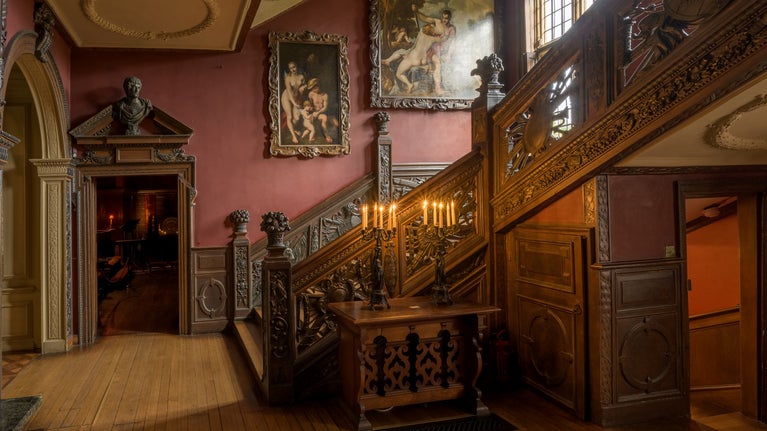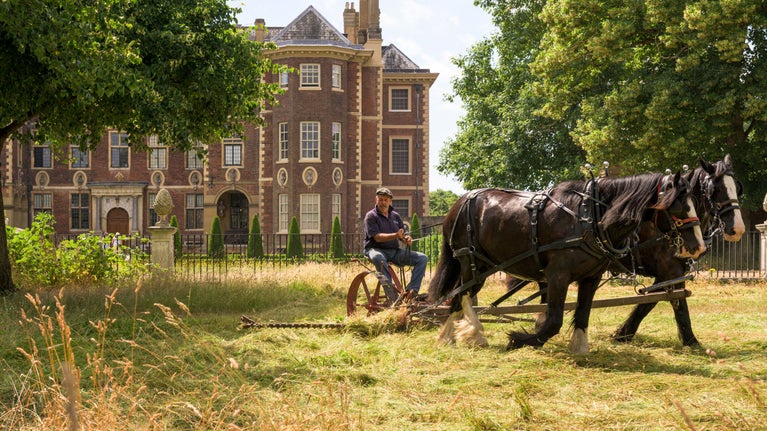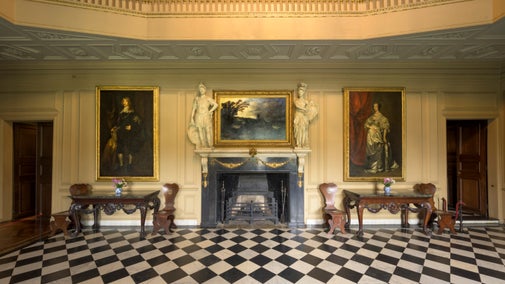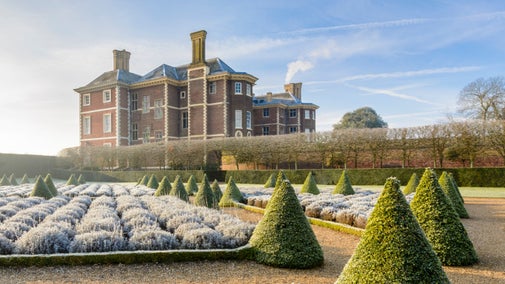
Donate
Everyone needs nature, now more than ever. Donate today and you could help people and nature to thrive at the places we care for.

Ham House and Garden has stood the test of time for over 400 years. Find out what happens behind the scenes to keep the historic house, collection and garden in top condition for future generations to enjoy.
Please note, the house is currently closed for winter conservation work and reopens on 14 February 2026. The gardens, café, shop and second-hand bookshop are open as usual during this period. Thank you for your understanding and support.
Both indoors and out, our work often follows the rhythm of the seasons and is varied, from using scaffolding for dusting at heights inside the Stuart house to mowing the riverside meadows around Ham House with horses.
Ham House is one of the places featured in the third series of BBC Two’s Hidden Treasures of the National Trust, which returned to screens in May 2025. The new series, narrated by Toby Jones, is available to watch on iPlayer.
We’re in episode four, ‘Women on the Frontline’, alongside Corfe Castle. Discover more about Elizabeth Murray, Duchess of Lauderdale, and see some of her most prized possessions undergo conservation.
From 16 May to 24 October 2025, visit Ham House to explore some of the objects featured in the series – gilded Dolphin chairs and a painting of Ham House by Hendrick Danckerts. Please note, the lacquer screen is still at The Royal Oak Foundation Conservation Studio.
The episode also shows how heavy horses are used to mow the meadows around Ham House.
Read on to learn more about how our staff and volunteer team cares for Ham House and Garden throughout the seasons.
Throughout the year every detail of Ham House is carefully inspected, cleaned and conserved. Our conservation team have a huge amount of knowledge about the collection and the specialist skills needed to care for it.
One day at Ham House might involve inspecting the moulded ceilings, with their fine cornicing and gilding. The next day, the team might focus on analysing the condition of intricate objects or polishing wooden floors which have been walked on by centuries of past inhabitants and visitors.

Our conservation team use specialist tools and techniques to carry out their work on collection objects and the house interiors. Some of our tools are adapted to our specialist needs, such as low suction hoovers which remove dirt without damaging objects.
If you spot us using some of this equipment or examining an object, feel free to ask us what we’re doing. It’s a privilege to get so close to these extraordinary objects but it’s even more of a joy to share the hidden details with visitors.
Conservation tasks are carried out weekly, monthly, quarterly, annually or sometimes only every 5-15 years. The latter includes cleaning tapestries, dusting the surfaces of paintings and larger projects such as looking after the external fabric of the building, including windows and brickwork. Tasks done weekly and monthly include cleans horizontal surfaces to remove dust and dirt brought into the house and checks of known mould hotspots, particularly in some of the damper areas of the basement. We also carry out quarterly pest checks to pre-empt and treat any potential infestation.
Our November weekday tours give an insight into our annual conservation work which takes place each winter.
The most involved conservation work takes place from early January and into February, while the house is closed to visitors, and during weekdays in November when the house is accessible by behind-the-scenes conservation tours.
It allows us to carry out delicate and more complex conservation tasks, such as putting up scaffolding to access the hard-to-reach places. It’s also an opportunity to look at objects and spaces from a different perspective and notice signs of wear that need our attention.
When we start the deep clean in the winter, we work in a logical way from the top to bottom of a room. It is amazing to see how much dust can accumulate after one year.
We have a large number of condition reports for each object in the house. Historic objects have their own personalities and quirks, and condition reports allow us to the track small but significant changes that tell us how an object is doing over the course of its centuries-long lifespan.
We also carry out important project work during the winter closure, such as building conservation which might affect larger areas or sections of the house.
Our work in the house includes, where possible, preventing damage from happening in the first place. Damage to fragile interiors and objects can be caused by fluctuating humidity, light, mould, pests, dust and dirt.
We carefully monitor each element. For example, inside the house you might notice small sensors which monitor temperature and humidity. Sensors in each room feed back to a central control system which automatically turns on the heating when the relative humidity gets too high.
Light is one of the main causes of damage to objects – leading to faded colours in fabrics and tapestries, in particular. The effects of light damage on paintings and furniture were well understood by people in the 17th century. If the family were away, furniture would be covered to protect it in their absence.
Today, we manage our light levels using a gadget called a lux meter to measure brightness. This ensures we can adjust our blinds and shutters to allow as much light as possible in for visibility, while still ensuring the collection is protected.

Ham’s historic borders, wilderness and productive kitchen garden re-create and reflect the garden of its 17th century residents. The garden team use a Conservation Management Plan to guide the garden’s development, making sure to balance its important history with the needs of visitors in the context of a changing climate.
The team at Ham have gardened using organic principles for over a decade; here are some of the ways we put nature at the centre of what we do:
Ham House’s Cherry Garden is a spectacular box parterre, filled with lavender and hundreds of metres of clipped topiary. Using a design inspired by the 17th century, we care for 80 large box cones and 250m of dwarf box hedging. When an eagle-eyed visitor spotted an unusual caterpillar on one of the box hedges, the garden team was concerned.
Native to Asia, the box tree moth (Cydalima perspectalis) was first reported in the UK in 2008. The caterpillars can turn a plant completely leafless, before damaging the wood and causing it to die. The plants in the Cherry Garden were quickly beginning to show patches of dieback.
After talking to a range of experts, the garden team starting using pheromone traps to catch male moths, monitor their numbers and lifecycle and help reduce the numbers reproducing. They also trialled a biological spray using a naturally occurring soil bacteria to control the population.
Help was also discovered from a surprising source – jackdaws. The small black crows were spotted feasting on box moth caterpillars, reducing fears that the insects weren’t attractive to native predators.
After noticing that the jackdaws were most effective on hedges that had been partially stripped of leaves, making the caterpillars easier to spot, we’ve been exploring pruning in a more open style that allows increased air flow and gives the birds easier access to the caterpillars.

Some of the meadows near Ham House, including the meadow between the front of Ham House and the River Thames, are also in our care. These areas are mowed by large 'draught' or 'heavy' horses, including breeds like Clydesdale and Comtois. Cutting the meadow in this traditional way helps to maintain the ideal conditions for native wildflowers to flourish. This helps to increase biodiversity and climate resilience in the meadows.
With your ongoing support, we're able to continue our vital conservation work. Thank you for helping to protect these special places.

Everyone needs nature, now more than ever. Donate today and you could help people and nature to thrive at the places we care for.

Inspiring, leading and resourcing the UK’s heritage to create positive and lasting change for people and communities, now and in the future.

The Big Lottery Fund, now called the National Lottery Community Fund, awards money raised by National Lottery players to fund great ideas that help communities to thrive.
From exploring the 17th-century house and strolling in the walled gardens to kids’ activities and space to enjoy a seasonal sweet treat, there’s something for everyone.

Explore the rich history of Ham House on the banks of the River Thames near Richmond – a rare example of 17th-century life, treasures and architecture; hardly changed in 300 years.

Explore the well-preserved interiors of one of the grandest Stuart houses in England, created to impress in the 17th-century by the Duchess of Lauderdale and her husband the Duke.

Games, activities, adventures – find lots of fun things to do for all the family at Ham House and Garden.
